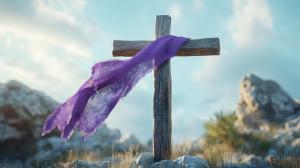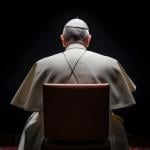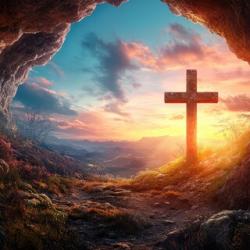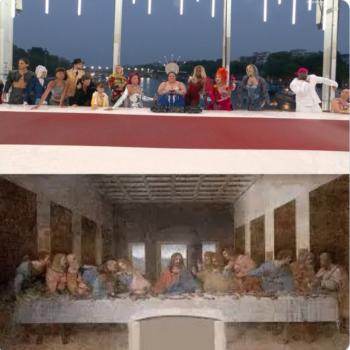
Palm Sunday is the first day of Holy Week, a week of joy and sorrow. The week begins with Jesus arriving in Jerusalem and ends with His death on the cross. Good Friday’s depth of sadness and despair will soon be replaced with joy on Easter morning. Due to the length of the gospel, I will focus on the main points. Let’s take a look.
Palm Sunday Gospel: Jesus’ Passion and Death
The gospel reading for Palm Sunday is Luke 22:14-23:56. There are some significant differences between the gospels on the Passion:
- Jesus washing the disciple’s feet is only found in the gospel of John
- Institution of the Eucharist and the “Agony in the Garden” are only in the Synoptic gospels (Matthew, Mark, and Luke)
- Jesus fell three times on the way to Calvary (this is not in scripture, but is Christian tradition)
The reading begins with the return of Jesus to Jerusalem as the crowd waved palms in joy:
“As he rode along, the people were spreading their cloaks on the road; and now as he was approaching the slope of the Mount of Olives, the whole multitude of his disciples began to praise God aloud with joy for all the mighty deeds they had seen. They proclaimed:
“Blessed is the king who comes in the name of the Lord. Peace in heaven and glory in the highest.” Some of the Pharisees in the crowd said to him,
“Teacher, rebuke your disciples.” He said in reply, “I tell you, if they keep silent, the stones will cry out!”
Palm Sunday Reading: The Last Supper
In the gospel of Luke, we read about the institution of the Eucharist.
“When the hour came, Jesus took his place at table with the apostles. He said to them, “I have eagerly desired to eat this Passover with you before I suffer, for, I tell you, I shall not eat it again until there is fulfillment in the kingdom of God.”
Then he took a cup, gave thanks, and said, “Take this and share it among yourselves; for I tell you that from this time on, I shall not drink of the fruit of the vine until the kingdom of God comes.” Then he took the bread, said the blessing, broke it, and gave it to them, saying, “This is my body, which will be given for you; `do this in memory of me.” And likewise, the cup after they had eaten, saying, “This cup is the new covenant in my blood, which will be shed for you.”
Palm Sunday Reading: The Agony in the Garden
In the “Agony in the Garden,” we see Jesus’ full humanity on display as he pleads with the Father to “take this cup from me.” Jesus, acknowledging His purpose God had intended for Him, follows God’s will despite His fears.
“Then, going out, he went, as was his custom, to the Mount of Olives, and the disciples followed him. When he arrived at the place, he said to them, “Pray that you may not undergo the test.” After withdrawing about a stone’s throw from them and kneeling, he prayed, saying, “Father, if you are willing, take this cup away from me; still, not my will but yours be done.” And to strengthen him, an angel from heaven appeared to him. He was in such agony, and he prayed so fervently that his sweat became like drops of blood falling on the ground. When he rose from prayer and returned to his disciples, he found them sleeping from grief. He said to them, “Why are you sleeping? Get up and pray that you may not undergo the test.”
The Road to Calvary
Jesus’ painful trek carrying His cross shows His love and trust in God.
“As they led him away they took hold of a certain Simon, a Cyrenian, who was coming in from the country; and after laying the cross on him, they made him carry it behind Jesus. A large crowd of people followed Jesus, including many women who mourned and lamented him. Jesus turned to them and said, “Daughters of Jerusalem, do not weep for me; weep instead for yourselves and for your children, for indeed, the days are coming when people will say, ‘Blessed are the barren, the wombs that never bore and the breasts that never nursed.’ At that time people will say to the mountains, ‘Fall upon us!’ and to the hills, ‘Cover us!’ for if these things are done when the wood is green what will happen when it is dry?” Now two others, both criminals, were led away with him to be executed.”
The Crucifixion
The gruesome process of crucifixion was intended to denigrate Jesus as a criminal further. This was a tortuous way to die. In the gospel of Luke, we do not have Jesus’ words on the cross, putting His humanity on full display, calling out to His Father, and asking why the Father has abandoned Him:
“When they came to the place called the Skull, they crucified him and the criminals there, one on his right, the other on his left. Then Jesus said, “Father, forgive them, they know not what they do.”They divided his garments by casting lots. The people stood by and watched; the rulers, meanwhile, sneered at him and said, “He saved others, let him save himself if he is the chosen one, the Christ of God.” Even the soldiers jeered at him. As they approached to offer him wine they called out, “If you are King of the Jews, save yourself.” Above him, there was an inscription that read, “This is the King of the Jews.”
The Two Criminals
Jesus was crucified along with two criminals. One mocks Jesus, but the other acknowledges Jesus as God. Jesus promises the criminal, “Today you will be with me in Paradise.”
Now one of the criminals hanging there reviled Jesus, saying, “Are you not the Christ? Save yourself and us.” The other, however, rebuking him, said in reply, “Have you no fear of God, for you are subject to the same condemnation? And indeed, we have been condemned justly, for the sentence we received corresponds to our crimes, but this man has done nothing criminal.” Then he said, “Jesus, remember me when you come into your kingdom.”He replied to him, “Amen, I say to you, today you will be with me in Paradise.”
Jesus Dies on the Cross
It was now about noon, and darkness came over the whole land until three in the afternoon because of an eclipse of the sun. Then the veil of the temple was torn down the middle. Jesus cried out in a loud voice, “Father, into your hands I commend my spirit,” and when he had said this, he breathed his last.”
A Time of Darkness
What starts as such a joyous occasion ends with darkness. We are all “post-Resurrection” people, so we know how the story ends. The people during Jesus’ time did not, and their despair and darkness from these events were overwhelming. The darkness was about to give way to the light of Easter morning.
Please let me know your thoughts about this article in the “Comments” section.
Peace


















